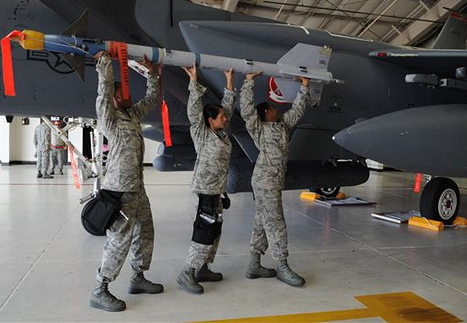Seymour Johnson Air Force Base
Seymour Johnson Field, Goldsboro, was activated on 12 June 1942 as Headquarters, Technical School, Army Air Force Technical Training Command. The following year it also assumed responsibility for preparing Air Corps personnel for deployment overseas as replacements and became the home of the Seventy-fifth Training Wing, which conducted a pretraining school for aviation cadets.
The 326th Fighter Group was assigned to Seymour Johnson in October 1943 and trained pilots for P-47 Thunderbolt aircraft from January 1944 until the end of World War II. The base also housed a number of German prisoners of war. It became an Air Corps separation center in September 1945 and was deactivated in May 1946.
In the early 1950s Goldsboro mayor Scott B. Berkeley, a World War I aviator, and John Dortch Lewis, a World War II aviator and prisoner of war, led a campaign to reactivate the base, working largely through longtime U.S. congressman Graham A. Barden of Sampson County. On 1 Apr. 1956 Seymour Johnson Air Force Base reopened as part of the Tactical Air Command, and in July it became home to the Eighty-third Fighter-Day Wing. The Eighty-third subsequently was designated the Fourth Tactical Fighter Wing (known as the Fourth Wing). The Fourth is famous for shooting down the greatest number of enemy aircraft in both World War II and the Korean War.
Since its reactivation, the base has been the quarters of the 482nd Fighter-Interceptor Squadron of the Air Defense Command, the 68th Bombardment Wing of the Strategic Air Command, the 19th "Suitcase" Air Force, and other units. The 482nd flew F-102 Delta Darts, and the 68th carried B-52 bombers. KC-10 tanker aircraft were also assigned to the base. The Fourth Wing and its predecessor, the Eighty-third, have flown F-86s, F-100s, F-105s, F-4s, and the F-15E. In the early 2000s the 4th consisted of two operational squadrons and two training squadrons, all equipped with F-15E Strike Eagles. The base was also home to the 916th Air Refueling Wing (USAF Reserve), which flew KC-135R tankers. A minimum security federal prison with 500 inmates was assigned to the base in 1991.
As of the early 2000s Seymour Johnson was the only air force base in the world named for a U.S. Navy pilot. Lt. Seymour Johnson, a test pilot, was killed in a crash near Norbeck, Md., on 5 Mar. 1941. After his death, his mother lived in Goldsboro and for many years served as head of the American Red Cross. The base was also unique in that it enjoyed one of the best reputations in the air force for community relations-a legacy of Berkeley, who was mayor of Goldsboro when the base was reactivated. The base housing development and a major thoroughfare leading to the base are named in Berkeley's honor; the Order of Daedalians chapter at the base bears his name as well. A huge set of air force pilot's wings adorned columns overlooking downtown Goldsboro near city hall, symbolizing the relationship between the civilian and military communities.
Additional Resources:
Seymour Johnson Air Force Base: http://www.seymourjohnson.af.mil/
Seymour Johnson NC Historical Marker F-59: https://www.ncdcr.gov/about/history/division-historical-resources/nc-highway-historical-marker-program/Markers.aspx?sp=search&k=Markers&sv=F-59
Image Credit:
"Crew from the 333rd Aircraft Maintenance Unit attempt to load an AIM-9 Sidewinder missile onto an F-15E Strike Eagle at Seymour Johnson Air Force Base, N.C., Aug. 2, 2012." Image courtesy of Flickr user CherryPoint. Available from https://www.flickr.com/photos/usairforce/7753432042/ (accessed August 30, 2012).
1 January 2006 | Price, Eugene
